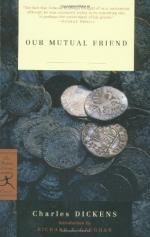|
This section contains 759 words (approx. 3 pages at 300 words per page) |

|
SOURCE: “Mutuality in Our Mutual Friend,” in Dickens Quarterly, Vol. 8, No. 3, September, 1991, pp. 127-34
In the following essay, Greenstein examines the many unifying themes and motifs highlighting mutuality in Our Mutual Friend.
J. Hillis Miller has argued that the milieus of Our Mutual Friend exist side by side without organizing themselves into a larger whole: the novel's “structure is formed by the juxtaposition of incompatible fragments in a pattern of disharmony or mutual contradiction” (Miller, 284). While most critics have accepted Miller's view, others like Masao Miyoshi have contested it in favor of a resolution of identity where “the two marriages are the inevitable outcome of the characters' final reconciliation of their own warring selves” (Miyoshi, 8). The pendulum swings again in John Kucich's analysis of Dickens's fantastic rhetoric: “it becomes impossible to say in any single way what Dickens means by concluding Our Mutual Friend in the way he...
|
This section contains 759 words (approx. 3 pages at 300 words per page) |

|


